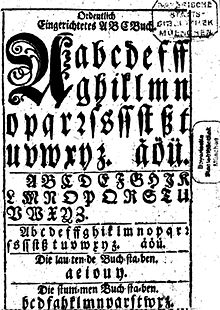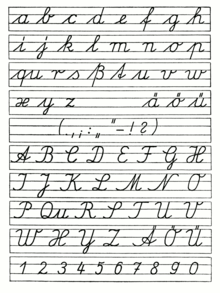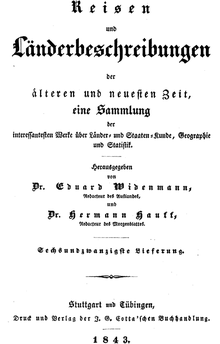German alphabet
The German alphabet is the alphabet that is used to write the German language . It is used in Germany , Austria , Switzerland , Liechtenstein and Luxembourg , as well as in countries with German-speaking minorities such as Belgium , Denmark ( North Schleswig ), Italy ( South Tyrol ) and Poland ( Upper Silesia ).
The German alphabet is an extension of the Latin alphabet . In today's standardized use, it includes the 26 basic letters of the Latin alphabet, the three umlauts (Ä, Ö, Ü) and the Eszett (ß) . In Switzerland and Liechtenstein, however, the ß is no longer used today (ss is written instead). The large Eszett (ẞ) was not included in the German alphabet until the 21st century.
| Capital letter | A. | B. | C. | D. | E. | F. | G | H | I. | J | K | L. | M. | N | O | P | Q | R. | S. | T | U | V | W. | X | Y | Z | Ä | Ö | Ü | ẞ | ||
|---|---|---|---|---|---|---|---|---|---|---|---|---|---|---|---|---|---|---|---|---|---|---|---|---|---|---|---|---|---|---|---|---|
| lowercase letters | a | b | c | d | e | f | G | H | i | j | k | l | m | n | O | p | q | r | s | t | u | v | w | x | y | z | Ä | ö | ü | ß |
The designations of the individual letters have neutral gender (neuter gender): "das A", "das B" etc.
Both in the spelling of dialects and in historical documents , numerous letter variants and other letters are and were used. The same applies to the spelling of foreign words , e.g. B. é and è often occur with an accent in French foreign words.

Development from the Latin alphabet
Origin of the umlaut letters
The umlaut letters (ä, ö and ü) were created from the combination of the respective Latin letter (i.e. a, o and u) with an e indicating the umlaut . They have only been in general use in this form since the 16th century. Today umlaut letters are also used in numerous other languages.
In Old High German manuscripts umlauts are designated only where an appropriate letter was available, namely e for short ä and later iu for long above sea after the diphthong to above monophthongiert was. The letters o and u could mean both o and u as well as ö and ü or üe in Old and Middle High German scripts .
Since around the 13th century, the ligature æ for long or openly spoken ä was used in some manuscripts , or an e or i was placed above the umlauted letter, and more rarely after it. In the German Kurrent script , which has been used more and more since the 16th century, this small e looks like two vertical lines that eventually became the two dots that are frequently used today. Some fonts still use the vertical bars for the umlaut letters.
The origin of the umlaut letters is still recognizable in today's writing, especially with family names such as Baedeker and place names such as Uerdingen or Oerlikon . If the umlaut letters are not available on a keyboard, ae, oe, ue is written regularly. In crossword puzzles , AE, OE, UE are usually written instead of Ä, Ö, Ü.
Origin of the Eszett
The Eszett (ß), also known as the sharp s , is originally a ligature from the long ſ (s) and either the round s or the z in the late medieval bastards and the modern Fraktur script . From around the beginning of the 19th century, the antiqua became more common in German-speaking countries. At that time, most of the Antiqua typefaces did not contain any letters for the ß , so prints from the 19th century are often set without ß. At the Orthographic Conference of 1901 it was determined that the type foundries would in future have to deliver their Antiqua typefaces with the letter ß and that a ß would have to be supplied for existing typefaces. The long s (ſ) was also occasionally used in the Antiqua, for example it can still be found in the Leipzig Duden from 1951.
Introduction of the great Eszett
SS is usually written in capital letters for ß, previously also SZ. In official documents, the ß was also used within capital letters , for example in the family name WEIß , in order to enable the distinction between white and white in capital letters . The creation of a capital letter was already discussed at the beginning of the 20th century, but none of the drafts caught on. The capital ß (uppercase eszett) was finally included in the Unicode Standard Version 5.1 on April 4, 2008 as "U + 1E9E" (ẞ) and on June 24, 2008 also in the ISO / IEC 10646 standard . The use of the uppercase eszett is mandatory for the official spelling of geographical names.
On June 29, 2017, the German Spelling Council included the capital ß in the official body of rules. Instead of STRASSE , you can now write STRAẞE with a capital ß. The spelling STRASSE is still common . This is also shown in the official regulations.
Naming the letters
A mere consonant is acoustically difficult to distinguish from others of its kind. Therefore the naming of the consonant letters differs from the usual sound-letter assignment . The following shows how the letters are usually named (pronunciation according to IPA ):
- A / a: [aː]
- Ä / ä: [ɛː]
- B / b: [beː]
- C / c: [t͡seː]
- D / d: [deː]
- E / e: [eː]
- F / f: [ɛf]
- G / g: [geː]
- H / h: [haː]
- I / i: [iː]
- J / j: [jɔt], in Austria also [jeː]
- K / k: [kaː]
- L / l: [ɛl]
- M / m: [ɛm]
- N / n: [ɛn]
- O / o: [oː]
- Ö / ö: [øː]
- P / p: [peː]
- Q / q: [kuː], in Austria [kveː] (except in mathematics)
- R / r: [ɛʁ]
- S / s: [ɛs]
- ẞ / ß : [ɛs't͡sɛt]
- T / t: [teː]
- U / u: [uː]
- Ü / ü: [yː]
- V / v: [faʊ]
- W / w: [veː]
- X / x: [ɪks]
- Y / y: ['ʏpsilɔn]
- Z / z: [t͡sɛt]
Especially when spelling it is helpful to pronounce a fixed word with the corresponding first letter instead of the letter, for example "Friedrich" for F. See German-language spelling tables .
In the script, letters are mostly noted as such, for example: "Vogel writes itself with V, not with F." For a few letters there are also clarifying spellings that are occasionally used. According to Duden these are:
- for J / j: Jot
- for Y / y: Ypsilon
- for Z / z: Zet or Zett
- for ẞ / ß: Eszett or sharp S (for other names see ß )
Order and sorting
Order of letters


The 26 basic letters (without umlauts and ẞ) have the following alphabetical order:
When listing the entire alphabet, the umlauts are usually added at the end, the ß either after s or together with the umlauts at the end of the lowercase letters. For example, in the official rules on the spelling reform, the characters are presented in two lines as follows and grouped with larger spaces:
- abcdefghijklmnopqrstu vwxyz ä ö ü ß
- ABCDEFGHIJKLMNOPQRSTU VWXYZ Ä Ö Ü ẞ
When whole words are sorted alphabetically, umlauts and ẞ are treated differently (see below).
Alphabetical sorting
The alphabetical sorting of words or names is basically based on the order of the letters in the alphabet. In the case of umlaut letters and eszett (ß) as well as the occurrence of digits and special characters, however, there may be deviations that depend on the exact area of application. For example, the DIN 5007: 1991 standard describes two variants:
- In the dictionary sorting (concerns common words) the umlaut letters Ä, Ö, Ü are treated like A, O and U (“age, older, old”), ß like ss.
- The phone book sorting (concerns names of persons), however, treats umlaut letters like Ae, Oe and Ue.
In Austria, other standards are sometimes used.
Frequency of letters in German
The most common letter is the E, followed by the N. The rarest letter is the Q. The type of text (poetry, prose, operating instructions, etc.) has no influence on the distribution of letters.
In the case of the letter pairs (bigrams), ER and EN are most common, mainly at the end of the word. The most common groups of three (trigrams) are SCH and DER.
Number of letters in the alphabet
When it comes to the question of how many letters the German alphabet contains, the first thing to note is the convention that upper and lower case letters are not counted separately. For example, A and a are not considered different letters, but rather two forms of the same letter. Correspondingly, letter forms such as the „(" long s ") and the ʒ (" z with sub-slings ") as well as ligatures - the merged spelling of two letters - are not counted as additional letters, but as special forms of letters (see glyph ).
However, it is not clear how many different letters are part of the German alphabet. Depending on how you understand the term " alphabet ", 26 or (less often) 30 letters are added to the alphabet, sometimes 27 letters:
- 26 letters - ä, ö, ü and ß are not counted.
- 30 letters - ä, ö, ü and ß are included.
- 27 letters - ß is counted as a letter, ä, ö, ü not.
In connection with the comparison of the numerous Latin alphabets and the question of how many letters they contain, it is obvious that the alphabet in question means the entirety of the letters that are used to write words in the respective language - i.e. in German not only the 26 letters from A to Z, but also the umlaut letters and the ß. Corresponding definitions can be found in the specialist literature. This results in the number of 30 letters in the German alphabet.
Otherwise, “alphabet” is usually defined as the entirety of the letters in a font that are arranged in a fixed order. The order of the letters is fixed in the German alphabet for the 26 letters from A to Z, but not for the umlaut letters and ß (see above for the order of the letters ). For this reason it is usually said that the German alphabet contains 26 letters. In this perspective, the umlaut letters and ß are taken into account, for example, with the wording that they are “added” or that there are also four additional “special letters”.
Another motive for counting only 26 letters in the alphabet can be that the umlaut letters and ß are not evaluated as independent letters to the same extent as the 26 letters from A to Z. They have developed from combinations of other letters ( see above origin) and can still be replaced today by letter combinations (e.g. ae for ä or ss for ß). In addition, the umlaut letters ä, ö, ü are written as the vowel letters a, o, u with a diacritical mark and thus appear as variants of other letters. In comparison, the ß appears more independent, because it cannot be interpreted as a variant of another letter. Against this background, the view is justifiable that the German alphabet comprises 27 letters (a to z and ß), while ä, ö, ü are to be regarded as the letters a, o, u with a diacritical mark. In connection with the introduction of the capital ß, the ß was referred to as the 27th letter of the alphabet.
Personal names with special characters
People with umlauts and / or ß in their names often have problems, as many electronic systems cannot process these letters and one has to resort to paraphrases (ae, oe, ue, ss). Especially in identity cards and passports, the name is then written in two ways, once correctly and in the machine readable zone (MRZ) in transcription (. Eg Schr ö the / WRITE OE THE Wei ß / WEI SS ). The same name can be spelled differently in different documents (credit cards, health insurance cards, BahnCard), which can cause confusion and suspicion of forged documents, especially abroad. Austrian identification documents can (but do not have to) contain an explanation of the German special characters (in German, English and French, e.g. 'ö' corresponds to / is equal to / correspond à 'OE').
Even before the introduction of the great ẞ was recommended ß in surnames in documents for reasons of clarity as uppercase to use (eg. As HEINZ GRO beta E).
German naming law recognizes special characters in the family name as a reason for a name change (No. 38 NamÄndVwV). Even a simple change in the spelling, e.g. B. from Schr ö the Schr to oe of Wei or ß to Wei ss , is regarded as such. On 1 October 1980, the Federal Administrative Court again found that the technically caused erroneous reproduction of special characters on electronic systems can be an important reason for the change of surname (the plaintiff spelling wanted his name of G ö tz in G oe change tz , but initially failed at the registry office; file number: 7 C 21/78).
literature
- Rules and dictionary. Revised version of the official set of rules 2004. Council for German Spelling , Munich and Mannheim, February 2006.
Web links
Individual evidence
- ↑ James Hoy, The Irish Spelling Book; or Instruction for the Reading of English, fitted for the Young of Ireland. Dublin 1740, p. 1/2, view in the Google book search
- ^ H. Paul, H. Moser, I. Schröbler: Middle High German Grammar , Tübingen 1975, ISBN 3-484-10233-0 ; § 6
- ^ Albert Derolez: The Palaeography of Gothic Manuscript Books: From the Twelfth to the Early Sixteenth Century . Cambridge University Press, 2003, ISBN 978-0-521-80315-1 , pp. 188 ( books.google.de ).
- ^ Bernhard Bischoff : Latin Palaeography: Antiquity and the Middle Ages . Cambridge University Press, 1990, ISBN 978-0-521-36726-4 , pp. 135 ( books.google.de ).
- ↑ Specification for the Unicode Standard, Version 5.1.0
- ↑ StAGN : Recommendations and instructions for the spelling of geographical names , 5th edition 2010
- ↑ New spelling rule: There is now a large Eszett in German rp-online.de, June 29, 2017.
- ↑ Official regulations, § 25 E3 : “When written with capital letters, you write SS . The capital letter ẞ can also be used. Example: Street - STRASSE - STRAẞE . "
- ↑ Duden defines a, A together as the "first letter of the alphabet".
- ↑ a b Example for counting 27 letters: Wolfgang Schindler, script for the lecture The German Writing System at LMU Munich , Version 03-20, p. 25 ( PDF download )
- ↑ Helmut Glück defines the alphabet in the Metzler Lexicon Language (2nd, extended edition, Metzler, 2000) as the "inventory of characters in an alphabetical writing system". Then it says: “Many A [lphabets] contain a larger number of letters than their alphabet list (in German, for example, ä, ö, ü, ß).” Thus, the umlaut letters and ß are expressly included in the German alphabet.
- ↑ So Diana Šileikaitė-Kaishauri ( University of Vilnius ): Introduction to Phonetics and Phonology of German ( PDF ), p. 45: "The German alphabet consists of 30 letters."
- ↑ a b Duden, Standard Wortbuch Deutsch als Fremdsprache (2018), keyword alphabet : “letters of a script arranged in a fixed order”, with the example sentence: “the German alphabet has 26 letters”.
- ↑ Cf. alphabet in the digital dictionary of the German language , section Etymology : “defined sequence of letters in a language”.
- ↑ a b Nese Kilinc: German language, difficult language: Causes of the problem with acquiring the second language German for Turkish children . Diplomica Verlag, 2015. p. 31 ( online at Google Books): “The German alphabet consists of 26 letters. In addition, the umlauts ä, ü, ö and the ß [...] are added. "
- ↑ a b The alphabet (PDF, source: Cornelsen Verlag , 2006)
- ↑ a b Interesting facts about the German alphabet deutsch-als-fremdsprache-lernen.de
- ^ Andreas Stötzner: The 27th letter. Logic and formation of the capitals eszett. In: Signa , Issue No. 9, 2006, pp. 39-61.
- ↑ Letter No. 27: The large Esszett merkur.de, May 11, 2009.



